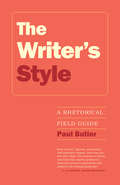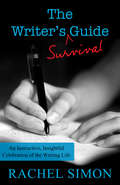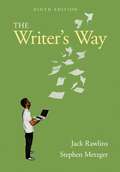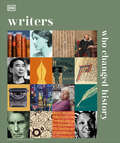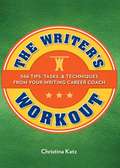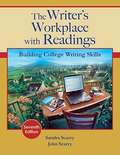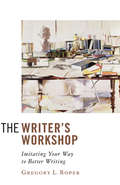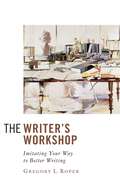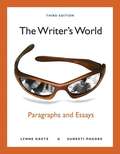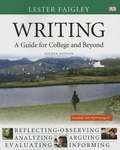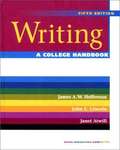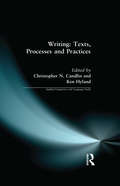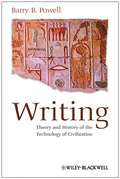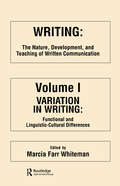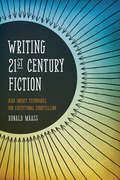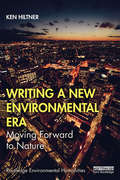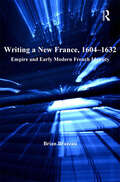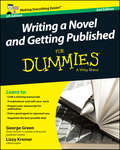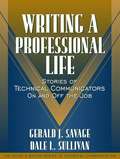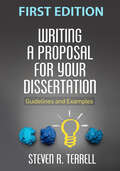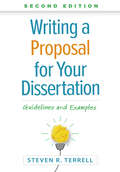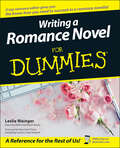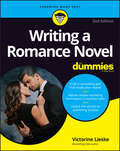- Table View
- List View
The Writer's Style: A Rhetorical Field Guide
by Paul ButlerDesigned to help all writers learn to use style as a rhetorical tool, taking into account audience, purpose, context, and occasion, The Writer’s Style is not only a style guide for a new generation but a new generation of style guide. The book helps writers learn new strategies inductively, by looking at firsthand examples of how they operate rhetorically, as well as deductively, through careful explanations in the text. The work focuses on invention, allowing writers to develop their own style as they analyze writing from varied genres. In a departure from the deficiency model associated with other commonly used style guides, author Paul Butler encourages writers to see style as a malleable device to use for their own purposes rather than a domain of rules or privilege. He encourages writing instructors to present style as a practical, accessible, and rhetorical tool, working with models that connect to a broad range of writing situations—including traditional texts like essays, newspaper articles, and creative nonfiction as well as digital texts in the form of tweets, Facebook postings, texts, email, visual rhetoric, YouTube videos, and others. Though designed for use in first-year composition courses in which students are learning to write for various audiences, purposes, and contexts, The Writer’s Style is a richly layered work that will serve anyone considering how style applies to their professional, personal, creative, or academic writing.
The Writer's Survival Guide: An Instructive, Insightful Celebration of the Writing Life
by Rachel SimonThis inspirational guide for aspiring and experienced writers was originally published in 1997. Written in a friendly, hopeful, and gently humorous tone, it focuses on the creative process and emotional ups and downs of the creative life, providing insights into how to persist in the face of rejection, frustration, feelings of inadequacy, lack of support from loved ones, and more. It also offers practical how-to advice, from organizing your time so you actually sit down and write to reading as a writer. This ebook's rerelease of The Writer's Survival Guide includes a new introduction that discusses the origins of the book and how, in spite of the many changes in publishing and technology, it remains relevant today.
Writer's Toolbox: Letters, Fairy Tales, Scary Stories, Journals, Poems, Reports
by Nancy LoewenTurn readers into writers. Using a single or small number of genre-specific works, this new series explores the tools all beginning writers need. Each title includes a review list of key concepts, at least four exercises for getting started, and numerous writing tips.
The Writer's Way
by Jack Rawlins Stephen MetzgerThe spirit of THE WRITER'S WAY remains in the ninth edition, as do its two core principles: (1) good writing begins when writers know their audience and write for the right reasons; and (2) knowing their audience and having good reasons to write will teach users everything they need to know about technique. Based on a “whole language approach,” THE WRITER'S WAY is a dynamic, process-centered paperback rhetoric with readings. While this book is intended to be used in a classroom, it's very much based on the concept that there is little difference between writing in school and writing in the “real world.” Offering frank advice in a supportive, encouraging tone, the authors lead readers step by step through the writing process, from pre-writing to polishing the final draft.
Writers Who Changed History (DK History Changers)
by DKExplore the fascinating lives and loves of the greatest novelists, poets, and playwrights.Lavishly illustrated with photographs and paintings of writers’ homes, studies, and personal artifacts—along with pages from original manuscripts, first editions, and their correspondence—Writers Who Changed History introduces the key ideas, themes, and literary techniques of each writer, revealing the imaginations and personalities behind some of the world’s greatest novels, short stories, poems, and plays.Introduced with a stunning portrait of each featured novelist, playwright, or poet, biographical entries trace the friendships, loves, and rivalries that inspired each individual and influenced their work, revealing insights into the larger-than-life characters, plots, and evocative settings that they created. Each entry explains how the person’s writing developed during their lifetime and sets it in context, conveying a powerful sense of the place and the period of history in which they lived.Covering an eclectic range of authors from the Middle Ages to the present day, Writers Who Changed History provides a compelling glimpse of the lives and loves of each great writer.
The Writer's Workout
by Christina KatzThe inspiration, stamina, and power to take charge of your writing life--every day.Get the daily jolt of energy your writing life needs from The Writer's Workout. Inside you'll find manageable, no-nonsense techniques for every aspect of your writing career from getting organized to connecting with your audience to building relationships.Veteran writing coach Christina Katz draws on her knowledge from more than a decade in the business to give you tips, exercises, and insider strategies to build your skills.Make your writing as strong and powerful as possible.Pitch and sell your work at every opportunity.Overcome rejection to come back better than ever.Promote your work and build an audience.Learn how to balance your creative life with your daily life.With The Writer's Workout, you'll develop skill, strength, and confidence - everything you need to build a robust, unique writing career that's built to last.Bonus online exclusive: Download a free motivational poster to keep you moving as your build your writing career at writersdigest.com/writers-workout.
The Writer's Workout
by Christina KatzThe inspiration, stamina, and power to take charge of your writing life'every day. Get the daily jolt of energy your writing life needs fromThe Writer's Workout. Inside you'll find manageable, no-nonsense techniques for every aspect of your writing career from getting organized to connecting with your audience to building relationships. Veteran writing coach Christina Katz draws on her knowledge from more than a decade in the business to give you tips, exercises, and insider strategies to build your skills. Make your writing as strong and powerful as possible. Pitch and sell your work at every opportunity. Overcome rejection to come back better than ever. Promote your work and build an audience. Learn how to balance your creative life with your daily life. WithThe Writer's Workout, you'll develop skill, strength, and confidence ? everything you need to build a robust, unique writing career that's built to last. Bonus online exclusive: Download a free motivational poster to keep you moving as your build your writing career at writersdigest. com/writers-workout.
The Writer's Workplace with Readings: Building College Writing Skills (7th Edition)
by Sandra Scarry John ScarryFor more than 20 years, THE WRITER'S WORKPLACE has served the needs of more than half a million two- and four-year students as they have worked their way toward rewarding careers in a variety of fields. Sandra Scarry and John Scarry present writing instruction in a clear and inviting form, with step-by-step explanations to help build and maintain students' confidence in their writing. The result of many years of classroom teaching and research, this comprehensive and time-tested resource reflects the authors' understanding that students are unique individuals, with diverse backgrounds and interests that must be accounted for as they engage in the writing process.
The Writer's Workshop: Imitating Your Way to Better Writing
by Gregory L. RoperThe Writer’s Workshop takes an approach to teaching writing that is new only because it is so old. Today, rhetoric and composition typically proceed by ignoring what was done for 2,500 years in Western education. Gregory Roper, on the other hand, helps students learn to write in the way the great writers of the past themselves learned: by carefully imitating masters of the craft, including Cicero, Thomas Aquinas, Charles Dickens, Sojourner Truth, James Joyce, and Ernest Hemingway. By living in their workshops and apprenticing to these and other masters, apprentice writers—like apprentice musicians, painters, and blacksmiths of the past—will rapidly improve the complexity of their art and discover their own native voices.Interspersed into chapters full of sound practical advice and challenging assignments are reflections on Great Ideas from “Realism and Impressionism” to “Nominalism and Modern Science.” Perfect for the college or even high school writing classroom—as well as a marvelous book for homeschoolers and others who would like to improve their own writing—The Writer’s Workshop is a fine practical guide, and Dr. Roper a friendly yet demanding teacher-mentor.
The Writer's Workshop: Imitating Your Way to Better Writing
by Gregory L. RoperThe Writer's Workshop takes an approach to teaching writing that is new only because it is so old. Today, rhetoric and composition typically proceed by ignoring what was done for 2,500 years in Western education. Gregory Roper, on the other hand, helps students learn to write in the way the great writers of the past themselves learned: by carefully imitating masters of the craft, including Cicero, Thomas Aquinas, Charles Dickens, Sojourner Truth, James Joyce, and Ernest Hemingway. By living in their workshops and apprenticing to these and other masters, apprentice writers—like apprentice musicians, painters, and blacksmiths of the past—will rapidly improve the complexity of their art and discover their own native voices. Interspersed into chapters full of sound practical advice and challenging assignments are reflections on Great Ideas from "Realism and Impressionism" to "Nominalism and Modern Science." Perfect for the college or even high school writing classroom—as well as a marvelous book for homeschoolers and others who would like to improve their own writing—The Writer's Workshop is a fine practical guide, and Dr. Roper a friendly yet demanding teacher-mentor.
The Writer's World: Paragraphs and Essays (3rd Edition)
by Lynne Gaetz Suneeti PhadkeThe Writer's World series was written to address the diverse needs of today's students: students whose first language is not English, students who respond favorably to visuals, and students who have varying skill levels.
Writing: A Guide for College and Beyond, Fourth Edition
by Lester FaigleyFor college courses in Composition and Rhetoric. Revealing the writing process through interactive learning Writing: A Guide for College and Beyond presents writing, reading, and research processes dynamically, using a variety of visuals to illustrate how readers interact with texts and how writers compose. One of the first textbook authors to focus on multimedia composing, Lester Faigley employs his own advice to engage students in every step of the writing process-for both college composition and everyday life-and pulls back the curtain on how writers work. Aligned with the learning goals for a first-year college writing course identified in the 2014 Outcomes Statement from the Council of Writing Program Administrators, Writing: A Guide for College and Beyond gives students the support they need to succeed in first-year composition, in their other courses, and in their careers. In the Fourth Edition, students can also practice and explore what they've learned chapter-by-chapter with interactive MyWritingLab tools, assignments and projects. Also available with MyWritingLab(tm) This text is also available with MyWritingLab(tm) - an online homework, tutorial, and assessment program designed to work with this text to engage students and improve results. Within its structured environment, students practice what they learn, test their understanding, and pursue a personalized study plan that helps them better absorb course material and understand difficult concepts.
Writing: A College Handbook (5th edition)
by James A. W. Hefferman John E. Lincoln Janet AtwillThe Fifth Edition exemplifies in clear, engaging prose the skills that students need to communicate in a wide variety of rhetorical contexts. A reliable and easy-to-use reference tool and an up-to-date rhetoric and research guide, Writing: A College Handbook invites students to discover the power of effective writing.
Writing: Texts, Processes and Practices (Applied Linguistics and Language Study)
by Ken Hyland Christopher N. CandlinWriting: Texts, Processes and Practices offers an innovative and multidisciplinary approach to writing in a variety of academic and professional settings. The book is composed of a series of original research-based accounts by leading authorities from a range of disciplines. The papers are linked through a unifying perspective which emphasises the role of cultural and institutional practices in the construction and interpretation of written texts.This important new book integrates different approaches to text analysis, different perspectives on writing processes, and the different methodologies used to research written texts. Throughout,an explicit link is made between research and practice illustrated with reference to a number of case studies drawn from professional and classroom contexts.The book will be of considerable interest to those concerned with professional or academic writing and will be of particular value to students and lecturers in applied linguistics, communication studies, discourse analysis, and professional communications training.The contributors to this volume are: Robert J. BarrettVijay K. BhatiaChristopher N. CandlinYu-Ying ChangSandra GollinKen HylandRoz IvanicMary R. LeaIan G. MalcolmJohn MiltonGreg MyersGuenter A. PlumBrian StreetJohn M. SwalesSue WeldonPatricia Wright
Writing
by Barry B. PowellWriting: Theory and History of the Technology of Civilization traces the origins of writing tied to speech from ancient Sumer through the Greek alphabet and beyond. Examines the earliest evidence for writing in Mesopotamia in the fourth millennium BC, the origins of purely phonographic systems, and the mystery of alphabetic writing Includes discussions of Ancient Egyptian,Chinese, and Mayan writing Shows how the structures of writing served and do serve social needs and in turn create patterns of social behavior Clarifies the argument with many illustrations
Writing: The Nature, Development, and Teaching of Written Communication
by M. Farr WhitemanFirst Published in 1982. Routledge is an imprint of Taylor & Francis, an informa company.
Writing 21st Century Fiction: High Impact Techniques for Exceptional Storytelling
by Donald MaassWhat is it that makes twenty-first century fiction different from twentieth century fiction? It's a real issue, attested by slush piles that are chock full of stories that are weak and lifeless. The writing is old-fashioned and stale, crafted by authors following outmoded and stifling "rules" once thought necessary in order to get published. Author and literary agent Donald Maass eliminates that restrictive philosophy by deconstructing the techniques used to craft successful (often best-selling) recent novels. He'll push you beyond the boundaries of genre, beyond outdated styles, and beyond your safety zones. You'll discover new ways of writing fiction that are personal, unique, and contemporary, resulting in fiction that is both literaryandcommercial.
Writing a New Environmental Era: Moving forward to nature (Routledge Environmental Humanities)
by Ken HiltnerWriting a New Environmental Era first considers and then rejects back-to-nature thinking and its proponents like Henry David Thoreau, arguing that human beings have never lived at peace with nature. Consequently, we need to stop thinking about going back to what never was and instead work at moving forward to forge a more harmonious relationship with nature in the future. Using the rise of the automobile and climate change denial literature to explore how our current environmental era was written into existence, Ken Hiltner argues that the humanities—and not, as might be expected, the sciences—need to lead us there. In one sense, climate change is caused by a rise in atmospheric CO2 and other so-called greenhouse gases. Science can address this cause. However, approached in another way altogether, climate change is caused by a range of troubling human activities that require the release of these gases, such as our obsessions with cars, lavish houses, air travel and endless consumer goods. The natural sciences may be able to tell us how these activities are changing our climate, but not why we are engaging in them. That’s a job for the humanities and social sciences. As this book argues, we need to see anthropogenic (i.e. human-caused) climate change for what it is and address it as such: a human problem brought about by human actions. A passionate and personal exploration of why the Environmental Humanities matter and why we should be looking forward, not back to nature, this book will be essential reading for all those interested in the future and sustainability of our planet.
Writing a New France, 1604-1632: Empire and Early Modern French Identity (Transculturalisms, 1400-1700)
by Brian BrazeauThe focus of this study is the exciting period of French overseas exploration directly following the stagnation caused by the Wars of Religion. The book examines the early period of French involvement in Northeastern America through readings of key texts, principally travel and missionary accounts. Among the works examined are travel writings by Marc Lescarbot (Histoire de la Nouvelle-France) and Samuel de Champlain (Voyages), and missionary works by Gabriel Sagard (Dictionnaire de la Langue Huronne, Histoire du Canada), Jean de Brébeuf, and Paul le Jeune (early Relations de Jésuites). Through a careful examination of these texts, the author discerns a French "rewriting of the self" in relation to the American other, represented by both land and people. America, Brazeau argues, allowed a consolidation of past markers of identity, and forced a radical rereading of others, due to the difficulties presented by the Canadian wilderness and its natives. Writing a New France, 1604-1632 sheds fresh light on a significant moment in French colonial history while providing an innovative contribution to the understanding of early modern French identity and cultural contact.
Writing a Novel and Getting Published For Dummies UK
by George Green Lizzy E. KremerLearn to: Craft a winning manuscript Troubleshoot and edit your work Prepare your manuscript for publication Find a good agent to represent you Negotiate the best possible deal Turn your aspiration into reality with this completely updated guide If you’ve always wanted to write that great novel, but never knew where to start, look no further! With a published author advising you on how to write well and a literary agent providing insight into getting a publishing deal, this updated guide gives you the inside track on the art and science of breaking into the fiction-publishing industry. Taking you step by step from concept to contract, this book provides the tools you need to tell your story with skill and approach agents and publishers with confidence. Dive in — check out how to combine your natural talent with the writing techniques used by successful authors Establish a firm foundation — construct your basic story, plot and structure Examine the key elements — create characters, develop dialogue, explore relationships and insert conflict Fine-tune and finish up — discover tips on adding detail, creativity and flair while bringing your work to a close Get published — take the next step by weighing up your publishing options, working with agents and negotiating deals Find out more — check out additional advice, like the most common mistakes you need to avoid, and tips from published authors Open the book and find: Tips for getting started Creative ways to develop plots, storylines, characters and dialogue The seven basic stories and how to put them to work Tricks for crafting a great ending to your novel How to prepare your manuscript for editing and publishing The lowdown on the business side of publishing
Writing a Professional Life: Stories of Technical Communicators On and Off the Job
by Gerald J. Savage Dale L. SullivanThis is the first collection of narratives by practicing technical communicators telling their own personal stories about the workplace and their lives on the job. The authors portray a wide range of jobs: writers, editors, interface designers, marketing writers, and trainers working in 9 different technical fields, including software, R&D, engineering , medicine, transportation, and telecommunications. The stories vividly demonstrate the unique power of narrative as a teaching and learning tool. Unlike fabricated cases, these real-life narratives show new and veteran technical writers at work on the job, dealing with tasks, clients, and co-workers, and revealing their insights, values, and attitudes about their work. The stories also show the skills required in the profession and the ethical and other issues raised in the course of the workday. For anyone interested in technical communication and professional writing.
Writing a Proposal for Your Dissertation
by Steven R. TerrellThis user-friendly guide helps students get started on--and complete--a successful doctoral dissertation proposal by accessibly explaining the process and breaking it down into manageable steps. Steven R. Terrell demonstrates how to write each chapter of the proposal, including the problem statement, purpose statement, and research questions and hypotheses; literature review; and detailed plan for data collection and analysis. Of special utility, end-of-chapter exercises serve as building blocks for developing a full draft of an original proposal. Numerous case study examples are drawn from across the social, behavioral, and health science disciplines. Appendices present an exemplary proposal written three ways to encompass quantitative, qualitative, and mixed-methods designs. Pedagogical Features: *"Let's Start Writing" exercises leading up to a complete proposal draft. *"Do You Understand?" checklists of key terms plus an end-of-book glossary. *End-of-chapter quizzes with answers. *Case study examples from education, psychology, health sciences, business, and information systems. *Sample proposal with three variants of the methods chapter: quantitative, qualitative, and mixed methods.
Writing a Proposal for Your Dissertation: Guidelines and Examples
by Steven R. TerrellThe encouraging book that has guided thousands of students step by step through crafting a strong dissertation proposal is now in a thoroughly revised second edition. It includes new guidance for developing methodology-specific problem statements, an expanded discussion of the literature review, coverage of the four-chapter dissertation model, and more. Terrell demonstrates how to write each chapter of the proposal, including the problem statement, purpose statement, and research questions and hypotheses; literature review; and detailed plans for data collection and analysis. "Let's Start Writing" exercises serve as building blocks for drafting a complete proposal. Other user-friendly features include case-study examples from diverse disciplines, &“Do You Understand?&” checklists, and end-of-chapter practice tests with answers. Appendices present an exemplary proposal written three ways to demonstrate quantitative, qualitative, and mixed methods approaches, and discuss how to structure a four-chapter dissertation. New to This Edition *Introduction offering a concise overview of the entire proposal-writing process and the doctoral experience. *Additional help with tailoring problem and purpose statements for quantitative, qualitative, and mixed-methods studies. *Expanded discussion of the review of literature, including a criterion for judging the quality of primary versus secondary sources. *Many new examples from different disciplines, such as studies of depression treatments, approaches to reducing offender recidivism, health effects of irradiated crops, strength training in college football, and remote teaching and learning during COVID-19. *Focus on the five-chapter model is broadened to include specific guidance for four-chapter dissertations. *Broader, more detailed reference list and glossary.
Writing a Romance Novel For Dummies
by Leslie WaingerIn love with romance novels? You’re not alone! Romance is today’s most popular fiction genre, accounting for more than half of all mass market fiction sold. If you’re looking to make a serious effort at writing a romance and getting it published in today’s multifaceted markets, you need to learn as much as you can about this highly successful field—especially how to create the perfect heroes and heroines. Now, in this easy, step-by-step guide, a top romance editor gives you the know-how you need to succeed as a romance novelist! Writing A Romance Novel For Dummies is perfect for both beginning and more accomplished writers who are looking to get the leading edge on writing a romance novel and get it published. Leslie Wainger, Executive Editor at Harlequin Books, explains what it takes to become the next Nora Roberts, providing the techniques you need to: Select a pseudonym Write a compelling, heartfelt story Find the right agent and publisher Submit a manuscript Market your novel Join clubs and associations Packed with insider advice, this plain-English guide helps you grasp the building blocks of a great romance, providing practical tips on the craft of writing as well as savvy pointers on how to hook your reader from page one, write with passion, and shape a proposal that will wow agents and editors. You get lots of expert tips on analyzing the marketplace, creating compelling characters, and finding your own voice. Wainger also: Demystifies the sub-genres of the romance world, from historical, contemporary, and multicultural to paranormal, romantic suspense, and Christian/inspirational Explains plotting, pacing, and writing those crucial love scenes Discusses how to conduct research, assign credits, and get permissions Helps you decide whether it’s best to write alone or with a partner Complete with a manuscript preparation checklist, tips for revising your work smoothly and successfully, guidance in understanding and negotiating a contract, and a list of romance writing resources, Writing A Romance Novel For Dummies is your one-stop guide to becoming a published novelist!
Writing a Romance Novel For Dummies
by Leslie Wainger Victorine LieskeGet your romance (writing) on! Writing a Romance Novel For Dummies is the only reference aspiring writers need to get their careers off to the right start. Fully updated to reflect the industry's latest trends and secrets, this book helps you understand what makes a great novel, so you can hone your craft and write books people want to read. We break down the romance subgenres, give you expert tips on plotting and pacing, and walk you through the process of finding an agent and getting published in today’s competitive market—or self-publishing like many six-figure authors are doing. For aspiring writers longing to find success in the industry, Writing a Romance Novel For Dummies is easy to read, highly informative, and a must-have! Refine your writing to craft engaging stories readers can’t put down Find a route to publication that works for you—mainstream, or self-published Understand the ins and outs of the romance genre and its subgenres Learn how to get your work noticed in the popular world of romantic fiction This Dummies guide is perfect for beginning writers who want advice on writing and publishing a successful romance novel. It’s also a great reference for accomplished writers looking to level up their romance game.
